I was often asked what kind of trim I have been applying to horses. There are different opinions and different approaches when it comes to hoof trimming as I meantioned before. Because of that, it is understandable that horse owners are often confused and feel the need to name different approaches and distinguish between different methods so that they can orient themselves and make the right decisions. Therefore, I have compiled a description of the method that I have been using, which I have called P3Trim. This trim proved itself very functional in restoring physiological shape of the horses hooves. To harvest the maximum potential of hooves to rehabilitate, it is crutial to provide the horse with sufficient amount of movement evenly spread over the day. Horses with thin soles need special attention and often extra protection in the form of hoof boots, plastic shoes or prolonged stay and movement on soft terrain. The primary reason is not the application of trim, but the fact that horses with thin soles often do not have well developed soft structures in the back of the foot, that are responsible for shock absorption. The ideal surface for barefoot rehabilitation of thin soled horses during the first few months is sand.
P3Trim utilizes similar tools as other methods, focusing on regularly shortening the hoof capsule to prevent overgrowth. However, its core distinction lies in the principles and reference points it employs, which guide the trimming process and enable the hoof capsule grow into its physiological shape.
P3 is a veterinary term used to refer to the coffin bone. I inserted this part of the hoof into the name of the trimming method, because the basic principles of P3Trim relate to the coffin bone and are as follows:
1) we trim in such a way as to allow the growth of a strong, evenly thick, healthy sole and a large, healthy frog.
2) we trim in such a way and with such frequency that the hoof walls grow closely adjacent to the coffin bone and internal structures, are not overloaded and thus do not deform.

It may sound surprising, but all the basic lessons can really be summarized in these two points. Let’s take a closer look at the reasons.
Ad1) Why do we need a strong, evenly thick, healthy sole? In addition to the fact that a thick sole, together with the arch, distributes point pressure when the horse steps on a stone with only its sole, an evenly thick sole tells us, even without X-rays, what position the hoof bone is in. The horn of the sole grows from the layer of epidermis which is on the solar side of the coffin bone and thus the sole copies its natural arch and its shape. If we try to artificially carve out the concavity with a hoof knife during trimming or otherwise interfere with the healthy wax layer of the sole horn, we thin this protection and at the same time disrupt the map from which we can read whether the plane of the hoof bone is placed in the correct position relative to the ground. Observations, dissections and X-rays show that if only the exfoliating horn is cleaned during trimming and the healthy waxy sole is not disturbed, the sole covers the hoof bone evenly over its entire lower surface. And together with surface stimulation, it can create a strong protective layer, even more than 1.5 cm thick, which allows the horse to walk even on rugged and rocky surfaces and to bear the horse’s weight in a great extend. Movement and close contact of the sole with the ground surface are essential for this process.
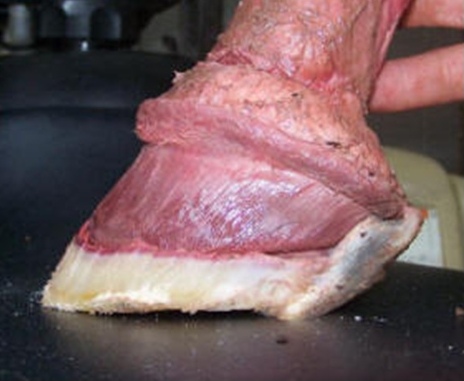
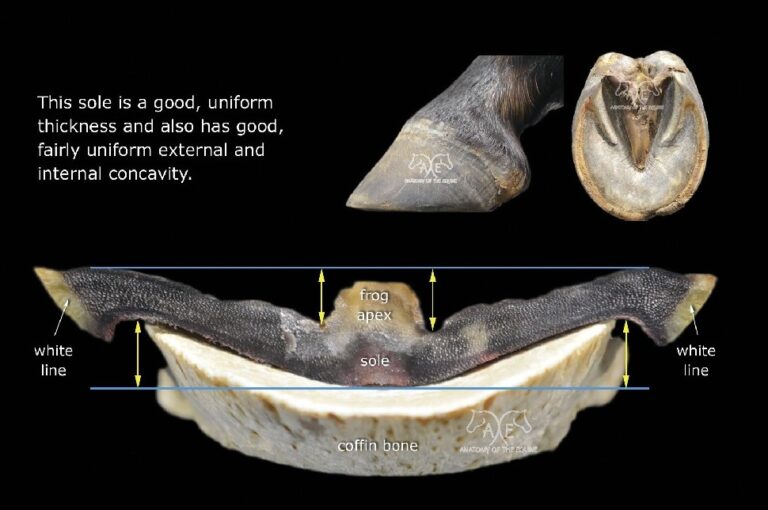
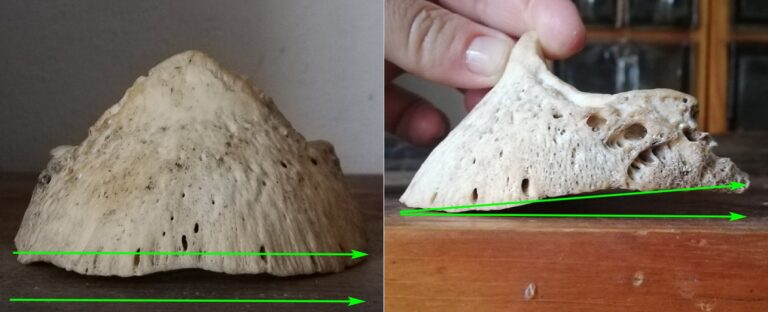
If principle 1) is not met, the hoof coffin bone may be tilted relative to the surface and the hoof walls grow and wear unevenly. Such a hoof capsule changes the position of the bones and joints located higher above the hoof bone, which can lead to irreversible pathology of the joint connections. This principle is often a fundamental difference in the thinking of barefoot hoof caretakers and farriers. Farriers pay attention first to assessing the horse’s posture and then adjust the hoof to correct any uneven posture. They often forget the fact that the hoof can be deceptive in its external shape, because most of the structures that we see from the outside are not always in the same position relative to the coffin bone and the rest of the bone column and their position changes over time. For example, the coronet is a soft structure that can be pushed more than 1 cm above its physiological level by overloaded hoof walls. In some hooves, we can see that in a certain place the coronet is higher on one side of the hoof than on the other. If the farrier does not take this fact into account, he can adjust the hoof so that the hoof capsule looks symmetrical from the outside, but the coffin bone inside is tilted laterally (from the dorsopalmar view) relative to the ground surface. The only structure that is firmly connected to the coffin bone and is permanently in one place relative to the bone column is the sole. Therefore, the plane of the sole can be a reliable reference point provided that its functional layer is not interfered with during each trim. If the hoof caretaker follows principle 1) from the horse’s early age, the rest of the horse’s skeleton and therefore its posture is naturally maintained in its physiological state. Some horses have certain genetically determined deviations, such as a slight deflection of the legs in the pasterns towards the outside or the inside. The above applies to a reasonable degree to these deviations. If foal hooves are neglected, then posture deviations can easily slip into pathology. On the other hand maintaining hooves in a physiological shape or as close to physiological as possible throughout the horse’s life depends can ensure good management even of crooced postures, especially by using short intervals between hoof trimming.
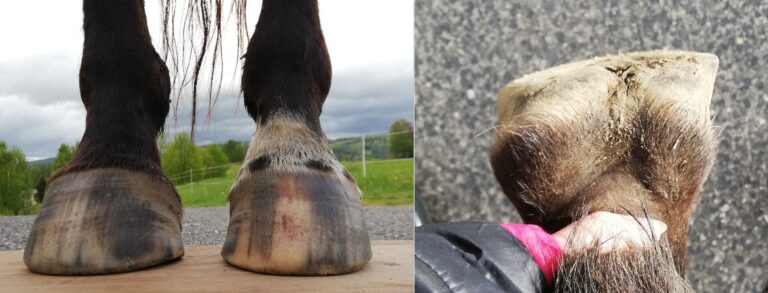
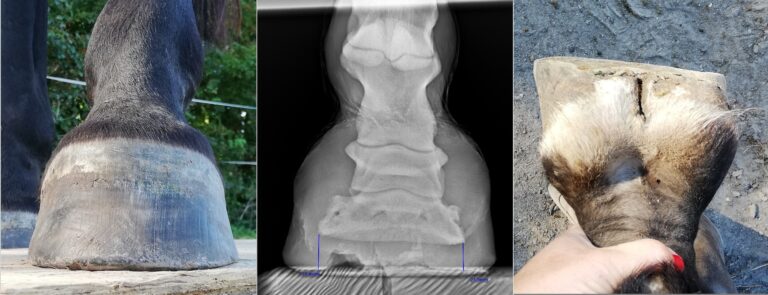
As for the frog, it is an important part of the hoof, which plays a big role in the dispersion of shock when the hoof hits the ground. Inside the hoof, the digital cushion connects to the frog. In a foal, the digital cushion is initially composed mainly of fatty tissue. Stimulation by surface and movement thickens it and stiffer cartilaginous tissue forms in it. If the conditions for the horse are ideal, the cartilaginous tissue soon forms a large part of the digital cushion and contributes to the horse’s comfortable movement. The frog is formed by callused horn and does not grow as quickly as the hoof walls. If we reduce the frog with each trim, we are taking away valuable mass from the horse and disrupting its growth and function. Experience shows that if the hoof capsule has a physiological shape, there is no thrush in the frog to the extent that disinfectants would be necessary. Contact of the frog with the ground and movement are essential for the maximum growth of a healthy digital cushion.
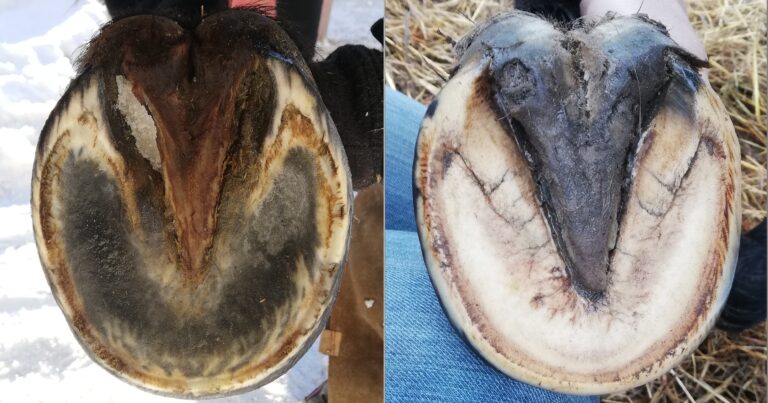
Ad2) When do the hoof walls not fit tightly to the hoof bone and internal structures? Observations show that this begins to happen when the horse, while walking and especially when standing, loads the hoof walls more than the sole and the frog for a long time, or when it loads mainly and only the hoof walls. At first, this is not visible, because the consequences of overload only become apparent over time, but it leads to varying degrees of defects and various consequences such as flares, cracks, long toes, seedy toes, underrun heels, changes in the course of the pastern axis, caudal failure, and the like. If the hoof walls do not fit tightly to the internal structures, this also affects the thickness of the sole, because when the walls form flares and therefore stretch to sides, the sole must also stretch to the sides instead of thickening. In addition, flaring weakens the lamellar connection with the coffin bone.
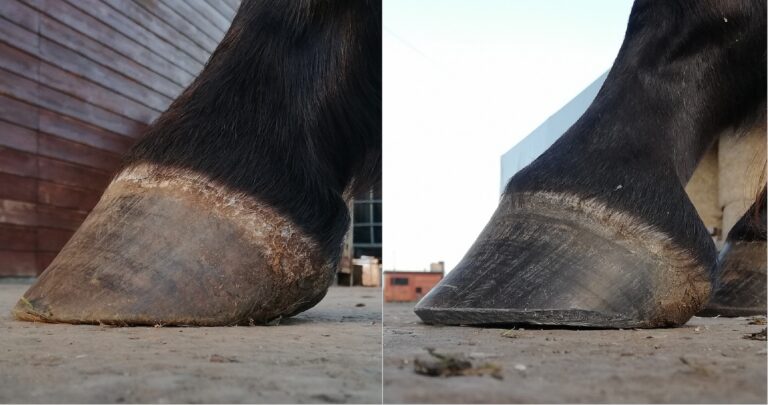
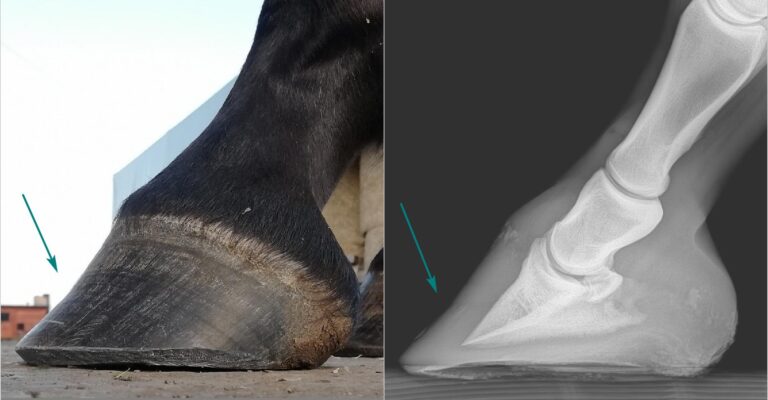
So how do the two basic lessons apply in practice? The goal of trimming is primarily based on the timely shortening of the constantly growing hoof walls and the non-invasive removal of dead horn of the sole and the frog. This type of hoof trimming tries to replace and imitate the ideal natural wear of wild horses moving on the ideal surface. If we do not want the hoof walls to be overloaded, we need to ensure that they do not bear the horse’s weight excessively in the long term, and we achieve this by transferring more weight to the sole and frog. Simply put, this means shortening the hoof walls sufficiently with each trim and thereby relieving the pull on the lamellar connection.
An integral part of P3Trim is taking photos of the hooves at regular intervals. Only with the help of photos we can objectively verify the current shape of the hooves, notice the details of the course of changes and monitor their development over time.
Basic procedure of P3trim
1) We thoroughly clean the entire sole, including the seats of corn, from any exfoliating material. This will tell us how much the hoof walls (peripheral walls, heels, bars) are overgrown and we will see the real concavity of the foot. If the concavity is missing, this most often indicates a thin sole, the appearance of flares, the presence of an old retained sole material, sometimes neglected bars which connected with the sole. If the concavity increases only slightly over time with the use of P3Trim, this indicates that the coffin bone itself already has a small concavity. We do not interfere with a healthy, functional wax sole horn.

Photo: Šárka Prokůpková
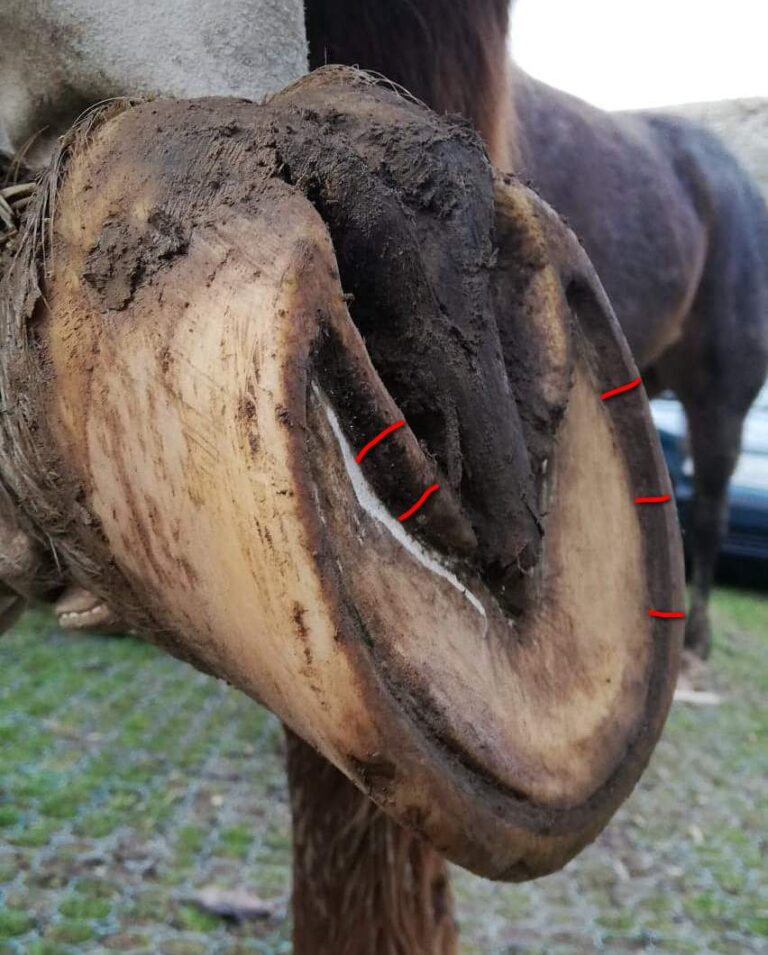
2) Trim the bars to the level of the wax sole or leave them 1-2 mm above the level of the foot if we want to allow the horse more traction. The bars should not be as high as the hoof walls after trimming (except for the heel area) or protrude from the foot above the level of the outer hoof walls.
3) Chip off or cut of the overgrown heels to create a supporting landing surface in the heels – a triangle of the seat of corn and heels. Lower the heels to the level of the foot or leave 0-2 mm of the height of the hoof walls, depending on whether the horse has a thin sole or not. Do not round the heels. Rounding underrun heels increases this pathology . Rounding the heels may be justified in the case of a club hoof, when the horse´s hoof lands toe first and high heels prevent it from landing heel first. In such a case, temporarily rounding the heels can make it easier for the horse to land on the heels.
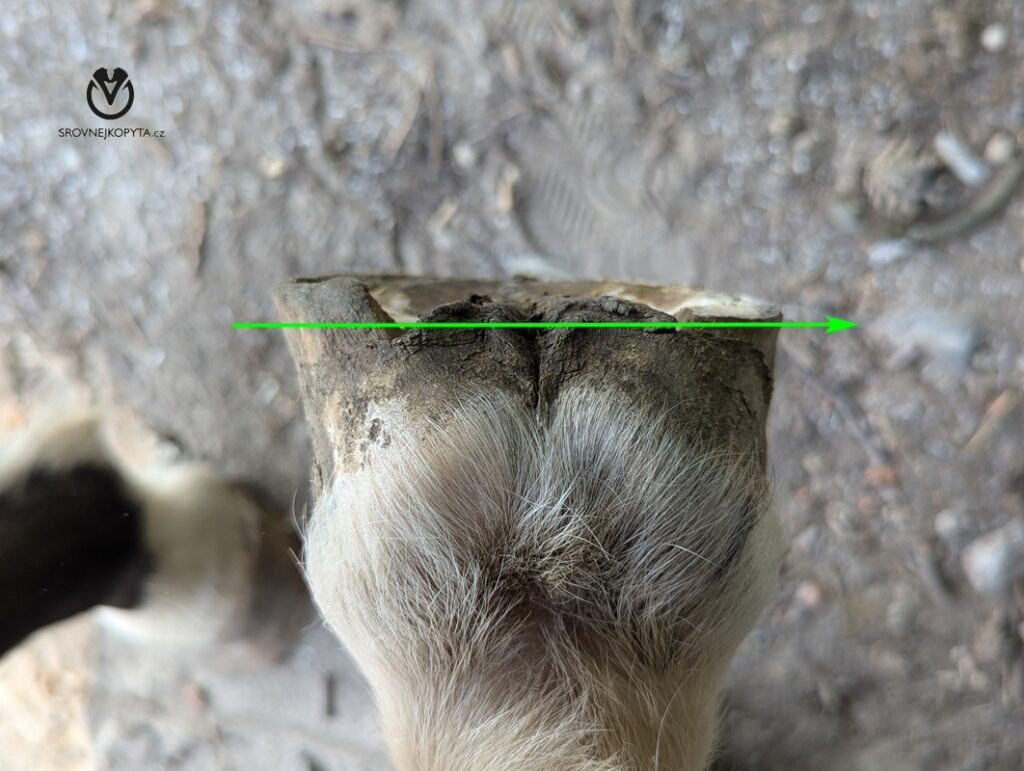
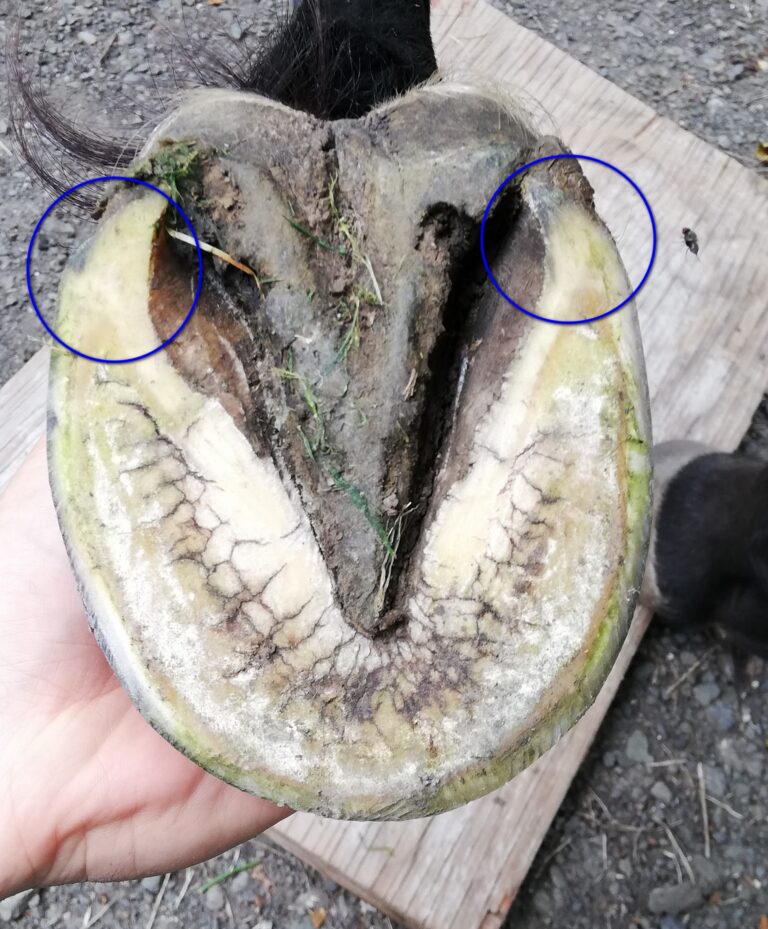
4) Shorten the rest of the peripheral hoof walls to the level of the sole.
5) From the level of the seat of corn, we bevel the peripheral hoof walls. The degree of beveling should be chosen depending on whether the trim is applied to the horse for the first time, whether the horse is in rehab, has concave or flat hooves, thin sole or not, a long toe, and according to the amount of movement. For flat hooves, it is good to initially bevel a smaller part of the width of the hoof wall, as well as for horses that have so much movement that they partially abrade the hoof walls themselves. For example, for horses inthat walk up to 8 km on pasture per day and are also used for recreational riding, it has proven to be effective to bevel most of the thickness of the hoof walls and leave only 1 – 2 mm.
For horses that (no longer) have any serious pathologies and are used extensively for riding, i.e. the hoof walls will be partially abraded by themselves with sufficient movement, or for example, if the owner trimes the hoof walls at shorter intervals than 4 weeks, the beveling can be omitted completely and the length of the walls can be regulated mainly in relation to the amount of movement. The ideal condition for many horses whose hooves are in a physiological state and have enough movement may be to maintain the hoof walls around the entire circumference, including the bars at the level of the sole. The decision depends on the number of km traveled per day, the degree of abrasion of the hoof walls and the comfort of the horse in relation to its use.
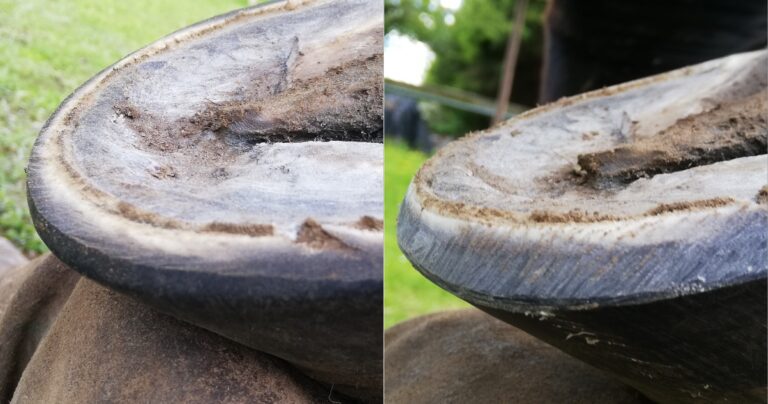
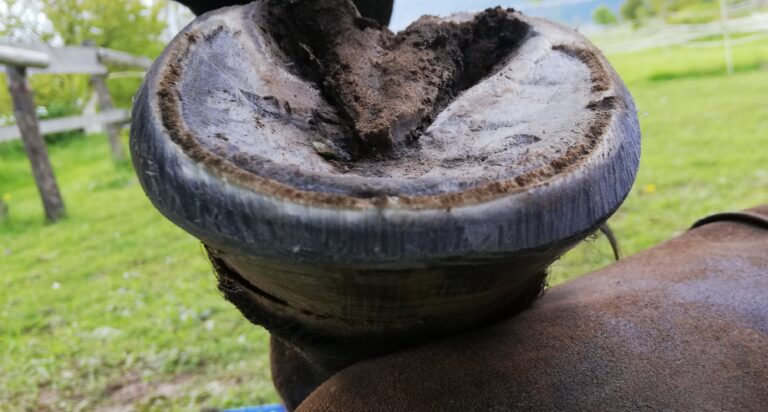

P3Trim can correct most common hoof deformities and pathologies:
- long toes
- underrun heels
- contracted heels
- flares
- atrophied frogs
- thin soles
- cracks
- high/low syndrome can be successfuly managed with addition of physiotherapy, complete correction is usually not possible, since the shortened deep flexor tendon plays a role here
- podotrochlosis, if the damage to the navicular bone does not exceed a certain limit
- consequences of laminitis depending on the degree of damage to the lamellar connection (it is crucial to first remove the trigger i.e. in most cases excessive food intake).
P3Trim functions as a prevention of all the above pathologies. For example, it does not prevent laminitis (because the triger lies in metabolic syndrom or overfeeding), but if the hoof is kept in a physiological state, the consequences of laminitis are not so serious and the physiological position of the coffin bone and the weight of the horses actively prevent rotation.
In order for a horse to be able to bear a greater portion of weight with the sole and frog without impairing gait, it is essential that the internal structures, especially the digital cushion, vascular system and lateral hoof cartilages, are in order. These structures participate in the dispersion of shocks. The vascular system also serves as a gel cushion between the hoof bone and the foot. If their function is impaired, the horse walks more cautiously for some time after the application of P3Trim. This fact must be taken into account, and the horse must be given enough time and movement on a soft surface (ideally sand, grassy surface) to find out to which extent these structures are able to rehabilitate. If the horse has a thin sole and the owner does not want to give up riding, the horse needs to be protected with boots or plasticshoes with support for the frog. In many cases, however, it is advisable not to burden the horse with riding for several months and give it time to rehabilitate. Some pathologies have very serious consequences for the rest of the body and it is not worth rushing rehabilitation. Most rehabilitations last 1-2 years and then the horse is in most cases fully fit again. So it is worth waiting.
Rehabilitation using P3Trim is very successful. It depends on how long the horse has had the hoof capsules in a non-physiological shape and how much it has affected the internal structures and the rest of the body. Hoof cartilage can ossify under excessive stress and their function of shock absorption ends. The coffin bone and navicular bone can succumb to osteoporosis. Such impairments are usually irreversible and it is necessary to adapt the future use of the horse to the given condition.
Comparison of different methods of adjusting horse hooves
I have found that most of the commonly used bare hoof trims that owners may encounter always work to some extent and all of these trims are capable of providing correction to at least some extent. The goal of all trims is to shorten the overgrown hoof walls. However, some trims prove to be insufficient in the long term, as they are able to improve the condition of very overgrown and deformed hooves in the short term, but they are no longer able to bring them to a physiological state and maintain them in such a state in the long term. This is often due to either a lack of understanding of the anatomical context or the use of inappropriate reference points. For example, some farriers adjust the length of the hoof walls relative to the crown. However, the crown is a soft, mobile structure that is not always anchored in the same place. Therefore, if the crown is out of its physiological position, determining the length of the walls according to its line will not lead to correction of the hoof capsule to a physiological shape. Hoof research is far from over and it is worth comparing different trimming methods to find out which ones are beneficial for horses with different uses in the long term and which ones are not. However, let’s not forget the influence of breeding conditions (amount of exercise) and nutrition.
The P3 Trim method has been tested on 100 plus horses so far. Many rehabs have been documented and proof very good results. For some hooves, the method has been used or monitored for less than a year, but changes in the shape of the hoof capsules are visible and occur in the same way as in horses that have been trimmed with this method for more than a year.
When photographing hooves and talking to horse owners, I noticed various differences in trimming horses‘ hooves. The observed differences in other methods available in the Czech Republic compared to P3 Trim are as follows (if interested, I would welcome more informative photos from representatives of individual methods, or additional descriptions of individual methods):
1) Farrier pasture trim – sometimes the soles are thinned, concavity is carved, frog is usually trimmed during each trim, sometimes carves part of the bars below the level of the sole, sometimes leaves the heels 2-4 mm above the sole, does not use hoof wall bevel and does not know this tool and its function. Sometimes mustangroll is applied (rounding the hoof walls) as an aesthetic matter. The hoof walls are perceived to be the primarily load-bearing structure. Farrier trimming styles vary, depending on the specific farrier. Trim frequency 6 – 8 weeks or more.
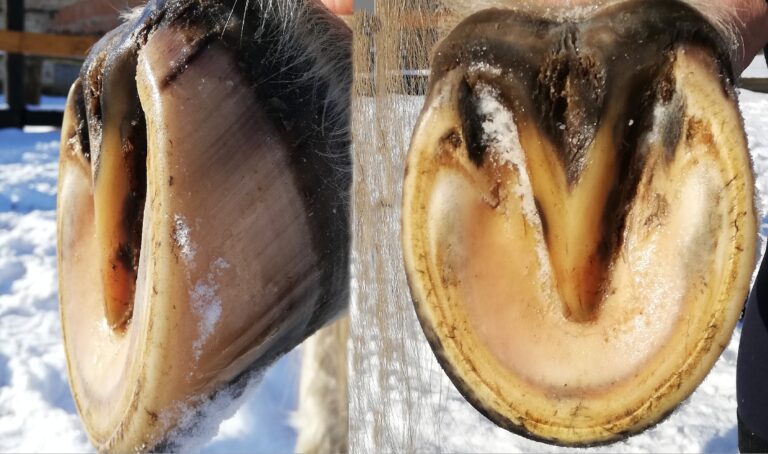
2) Dr. Strasser’s method (germen method)- thinning the sole (the sole should give way to pressure at the tip of the toe when pressed with the fingers) and uniform trimming of the frog at each trim, does not use bevelling, mustangroll as an aesthetic matter. Considers hoof walls as primarily weight – bearing structure.
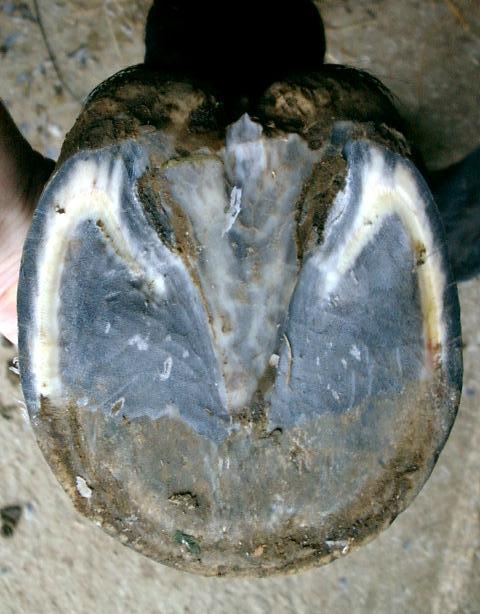
3) Mustang trim (Czech method inspired by David Landreville)– general rounding of the heels, leaving the „ramp“ and heels 2-4 mm above the foot, frog is trimmed during each trim, uses mustangroll to relieve the hoof walls from excesive weight bearing.
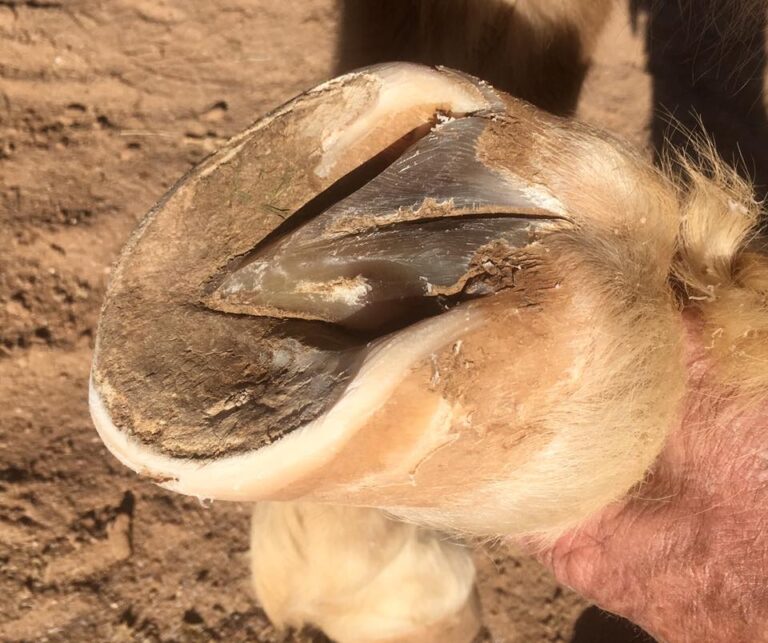
4) HGM trim – leaving the heels 3-5 mm above the level of the sole, leaving the „ramp“ (smooth transition of the hoof walls from the quarters to the heels) 1-3 mm above the sole. Doesnt trim the frog during each trim.
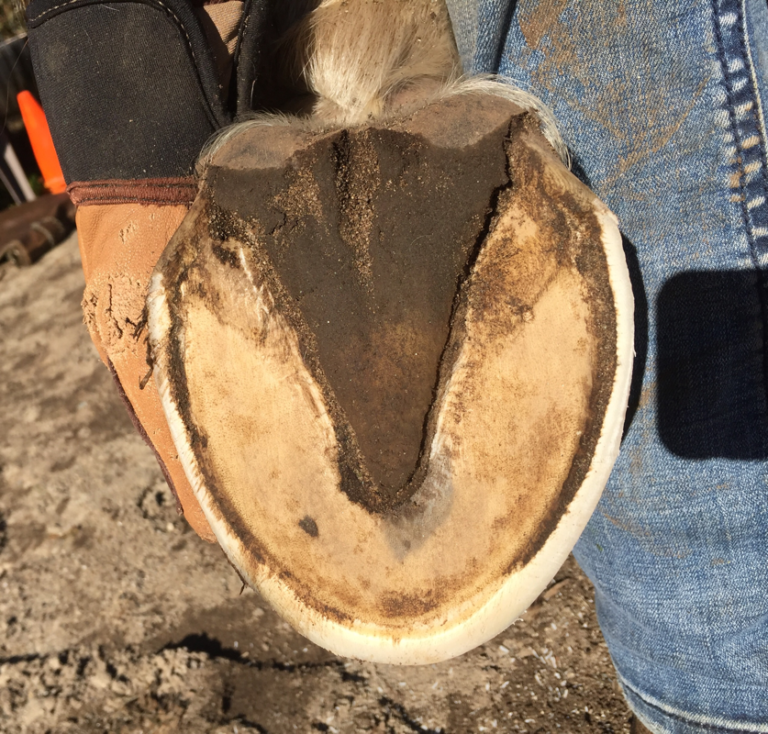
P3Trim samples
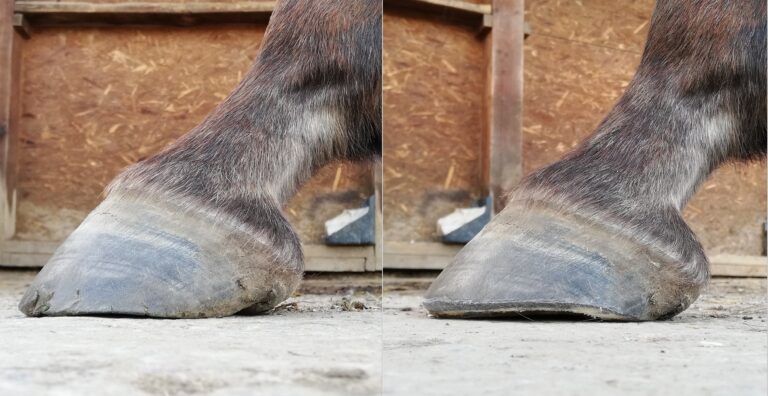
Photo: Šárka Prokůpková
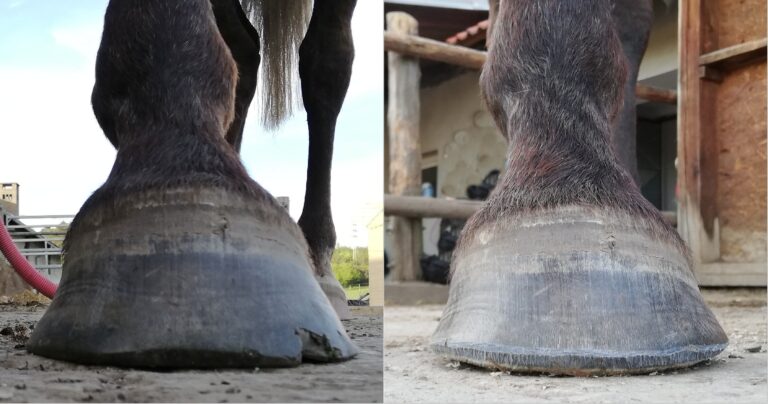
Photo: Šárka Prokůpková
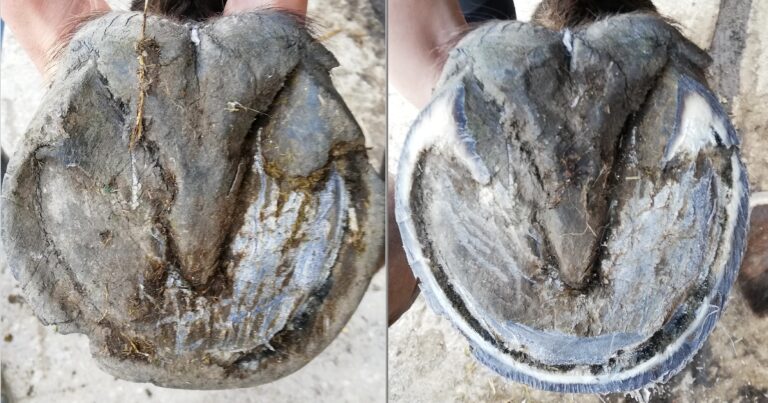
Photo: Šárka Prokůpková

Photo: Šárka Prokůpková
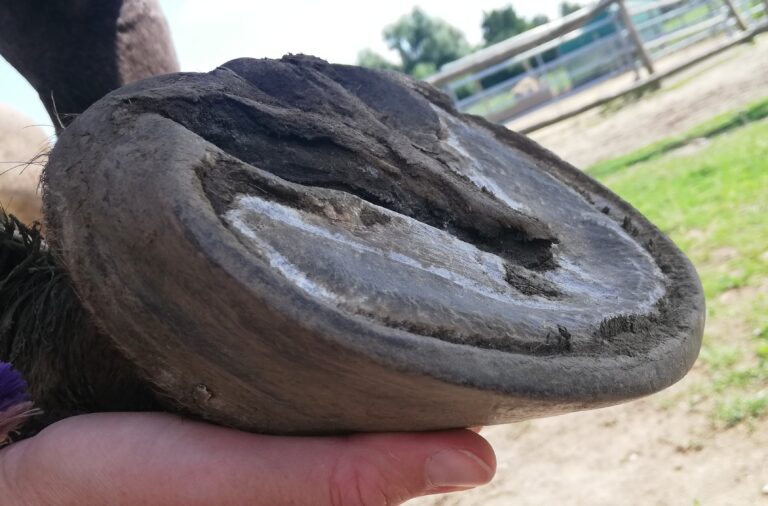
Photo: Šárka Prokůpková
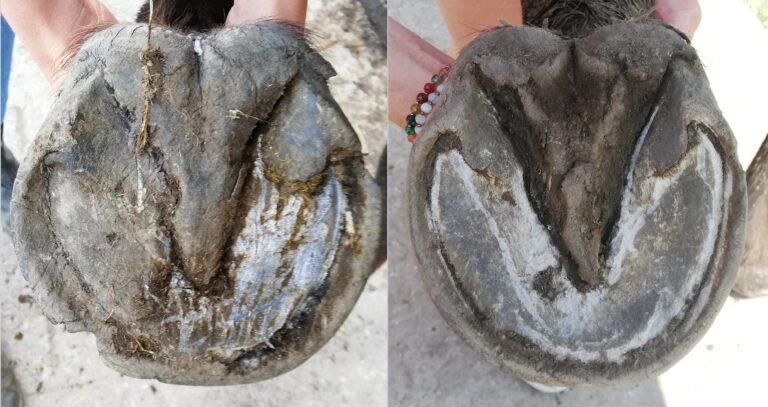
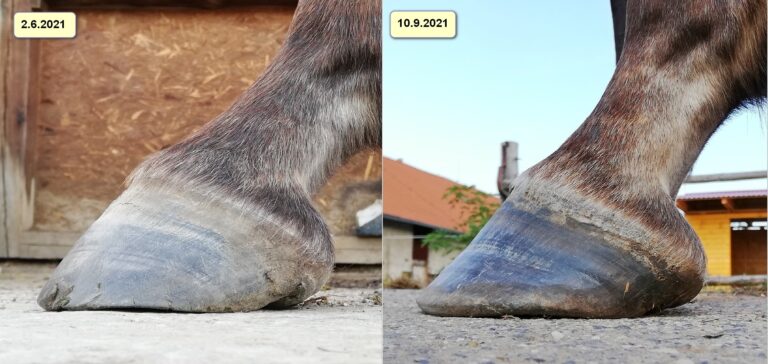
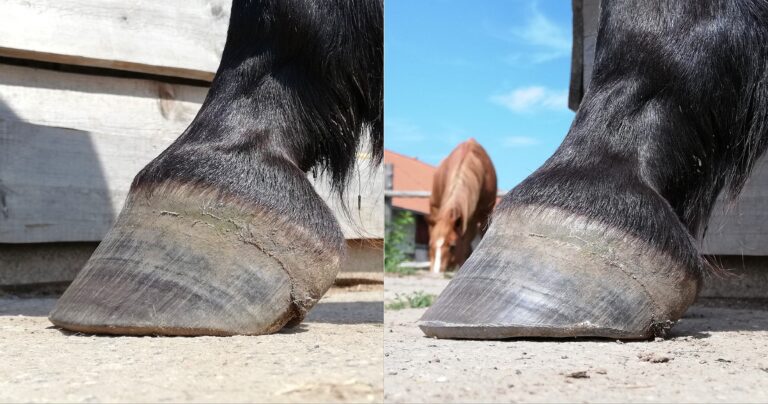
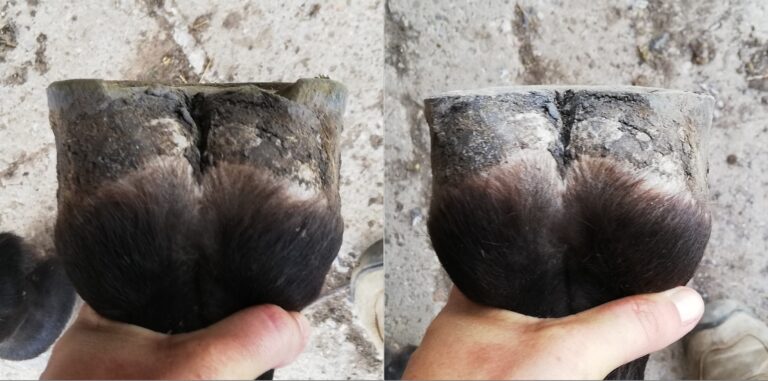
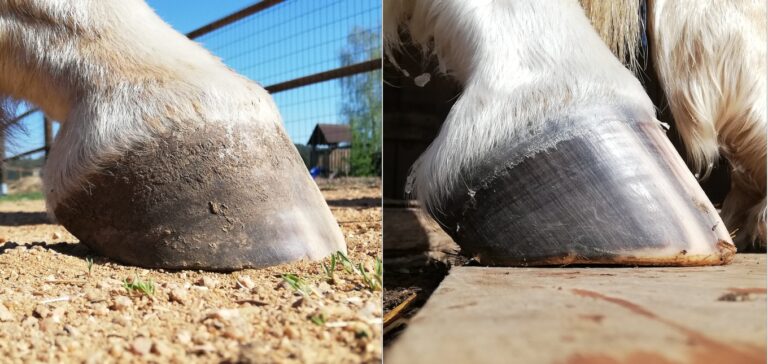
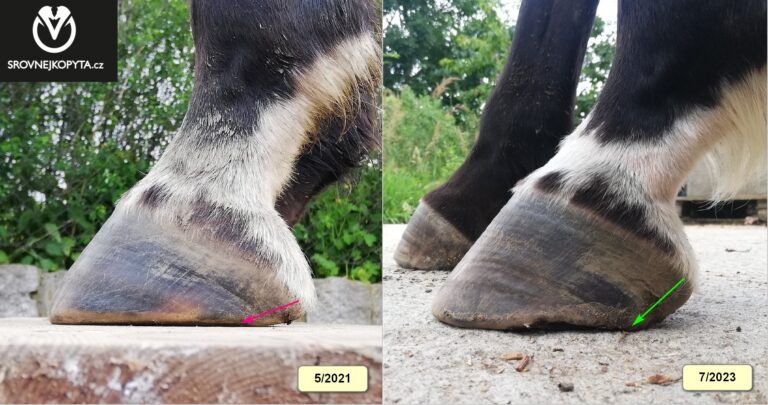
P3Trim is in agreement with latest research of many scientists, farriers and barefoot trimmers for example: Dr. Robert Bowker, Pete Ramey, Yogi Sharp, Mike Savoldi or Alicia Harlov.
Frequently Asked Questions
How is P3trim different from farrier trim?
Farrier trim in most cases does not use any tool for long-term relief of the hoof walls (mustangroll or bevel). At the same time, it considers 6-8 weeks to be a sufficient trim frequency compared to P3Trim, which is a maximum of 5 weeks for a healthy hoof (8 week in winter time when horn grows slower) and even less than 5 weeks for hooves in rehabilitation. The basis of farrier trim is the belief that the hoof walls are primarily load-bearing, and the sole and frog help little bit to carry the weight of the horse. P3Trim, on the other hand, is based on the observed and scientifically supported fact that the sole and the frog are destined (with help of other inner mechanisms like blood network) to carry a greater portion of weight than the hoof walls, and this is also beneficial for the hoof in the long term, because over time the lamellar connection (suspensory apparatus) does not become overloaded and generally known and widespread pathologies do not arise (cracks, flares, underrun heels, atrophied digital cushions, acute hoof deformities, etc.). Farrier trim also often interferes with healthy live sole and frog. From the perspective of P3Trim, it therefore removes an important layer from the hoof, which is then unable to protect the horse from point pressure and does not allow it to disperse shocks well. Farrier trim takes care of the alignment of the horse’s posture, i.e. it tries to adjust the hoof so that the axis of the forelimbs runs perpendicular to the ground, and in the case of the hindlimbs, so that the hock-hoof axis runs perpendicular to the ground. This adjustment can be at the expense of the position of the coffin bone in relation to the surface. The hoof capsule can be optically aligned according to the farrier’s wishes, but the coffin bone inside the hoof capsule can then be place sideways in relation to the ground surface. The horse’s weight is then distributed unevenly in the hoof, causing overloading of other parts of the hoof and other parts of the body.
Why is the trimming frequency of 6-8 weeks not sufficient?
By trimming the hooves, we simulate the abrasion of the hoof, which is insufficient in most cases for horses in the Czech Republic, because the way horses are bred does not allow them to walk a sufficient number of kilometers per day (many horses walk only 3 – 5 km a day instead of 10-30 km). If a domesticated horse is used for regular riding plus has, for example, enough exercise on pasture, it is realistic that the hooves will be worn mostly by movement and friction against the surface, and trimming in such a case does not necessarily have to be done every 4-5 weeks. Farrier pasture trim can be very functional in such a case (if it does not take away too much of the valuable mass of the sole and frog). However, the reality is that most horses do not walk a sufficient number of kilometers and if trimming is done every 6-8 weeks, the horse overloads the hoof walls in the long term. The effects of overload accumulate over time, leading to various hoof capsule deformations that eventually impact other parts of the body and the horse’s overall health. For shod horses, a re-shoeing cycle of 4–5 weeks is often critical, as the attached shoe prevents the hoof walls from making contact with the ground, eliminating natural abrasion.
Will P3Trim help a horse with a thin sole?
Yes in most cases. There is exceptions in cases when the trim is neglected from very early age, longterm shoeing (more than 10 years continuously) combined with not enough movement. With regular application of P3Trim, flares stop forming and the hoof walls grow close to the coffin bone and other internal structures. The foot does not have to expand in width or length, and with sufficient movement, the sole thickens over time and protects the horse from uneven surfaces. The exception is horses with metabolic syndrome, in which the source of metabolic problems has not been removed, i.e. pasture or another rich source of nutrients. Such horses develop flares even with the application of P3Trim. This is probably caused by a combination of influences. The lamellar connection is weakened and even slight surface pressure allows flares to form. It is possible that hormonal imbalance directly affects the formation of the sole or the function of the blood circulation. However, P3Trim will at least prevent acute laminitis with rotation of the coffin bone in such horses, because by applying P3trim regulary, the horse’s skeleton is not suspended in the hoof capsule (lamellar connection). When pasture, as rich source of nutrients, removed and enough movement added to the equation (establishing a balance between nutrient intake and output), P3Trim will enable proper foot function even in horses with metabolic syndrome.
Will the horse walk well after removing the shoes and applying P3Trim?
Horses that wear shoes continuously for a certain period of time have weakened soles, frogs and often also blood circulation. When going barefoot, it is necessary to give the horse sufficient time for rehabilitation. If you cannot provide time, don´t go barefoot. For horses that have worn shoes for only a few months, rehabilitation is shorter and less restrictive than for horses that have worn shoes for several years. Depending on the length of time the horse has worn shoes, different horses may experience different degrees of discomfort after removing the shoes. Example from field 1: A horse that had worn shoes for about 3 years walked very carefully on hard and rocky surfaces for 3 months. It moved normally on grass and the owner did not use boots during rehabilitation. The horse was used for light recreational riding throughout, except for one week when its heel bulbs were warm. Example from field 2: A mare that had been wearing horseshoes for 12 years was sensitive even on grassy surfaces for about 2 months after removing the horseshoes. The first week after removing the horseshoes and the first trim, she did not move much on the grass paddock and often stood still. She gradually began to graze and walk. Extremely sensitive on hard surfaces and stones. The owner continued to use the mare for light work on the sandy riding arena and used shoes when riding out, which helped the mare a lot. For the first two months, the mare moved more stiffly on the riding arena than before removing the horseshoes. After 3 months, the movement began to improve and return to normal.
Some horses need to be given a complete break from riding for several months and only do groundwork (usually applies to ex-race Thoroughbreeds). The ideal surface for barefoot transition is sand. However, few people have a sandy surface in their stables, and a functional alternative is a grassy pasture without stones. Going barefoot or rehabilitating a barefoot horse with pathological hooves can be challenging for the horse at first. The owner should also prepare well mentally for the process. It is usually enough to allow the horse to stay calm and move on a comfortable surface. It is often not necessary to try to protect the hooves with boots immediately. It is useful to watch the horse and observe how the process of restoring the function of the hoof is taking place. The structures of the hoof have a great ability to restore and immediately respond to new conditions (stimulation of the sole, the frog and blood circulation). In some horses, after removing the horseshoes, the hoof walls break off for a while because they are weakened, and in some horses an abscess may form. These are all natural processes that the owner does not need to worry about. As the hoof rehabilitates, all these symptoms gradually disappear and do not recur. The fact that many horses experience great discomfort during rehabilitation or after removing their shoes shows us how important it is to focus on prevention and, in the first place, not to allow horses‘ hooves to reach a state where they are unable to painlessly use the hoof structures for the function they evolved to perform.
Will it hurt the horse if I trim the hoof walls?
When switching to P3Trim, it is recommended to do the first and second trim to a smaller extent and leave the horse 3 mm of hoof wall width when trimming instead of just 1 mm. At the same time, it is better to leave the horse’s hoof walls in the heels about 1-2 mm above the level of the live sole, instead of trimming the heels to the level of the live sole. This will allow the horse to cope with the new weight distribution on the hoof structures. If the horse’s hooves are in a pronounced non-physiological shape (very long toe, underrun heels, thin sole, undeveloped frog), the horse is often more sensitive on hard and rocky surfaces for several months. If the horse walks more carefully, this does not necessarily mean that the horse is in pain.. Even the nerve endings in the hoof must restore balance in the perception of the surface, and foreign professionals are convinced that the horse may experience a tingling sensation for some time.
Can I trim a shod horse?
I have seen light bevel being applied by a farrier, before the shoe was attached. This needs more examining but I would say partially yes.
Can I ride immediately after P3Trim or do I need to give my horse a few days rest?
The possibility of riding depends on the health of the hooves and the lenght of ride. If the hooves have a shape close to physiological, in most cases it is possible to ride the horse immediately after the application of P3Trim. If the hoof shape is non-physiological, it may be appropriate to give the horse some time for rehabilitation. If P3Trim is applied to the horse for a long time, riding is possible immediately after trimming.
What is seat of corn?
The seat of corn is the name given to the part of the foot where the bars and heels converge. It is the corner of the sole in the heels. Old sole often accumulates in this place. If the seats of corn are not thoroughly cleaned of old horn before trimming, we can then insufficiently shorten the hoof walls in the heels and over time contribute to the formation of unphysiologically high heels.
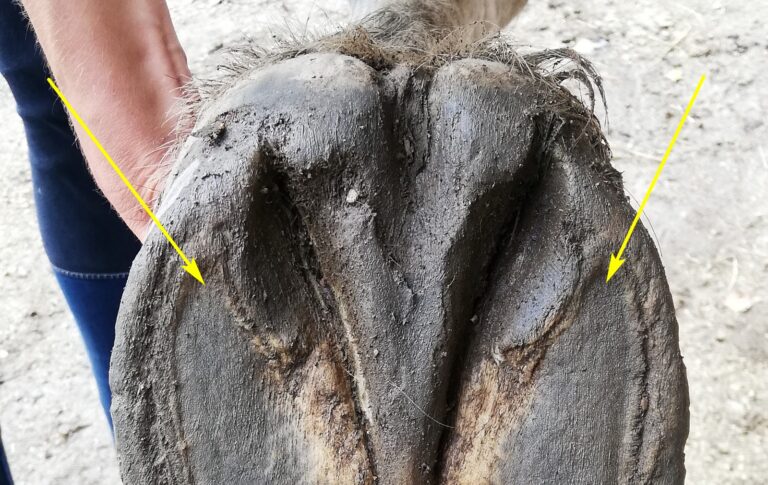
Why doesn’t P3Trim use heel rounding like Mustang Trim?
Photographic evidence has shown that heel rounding in horses with under-turned heels causes even greater under-turning or stagnation in the correction. Heel rounding is justified in the case of club hooves or hooves with high heels, when these high heels cannot be shortened to a physiological height in one go. In such a case, rounding makes it easier for the horse to step on the heels when making the stride. If the heels are too high, the horse can hit the surface prematurely with its heels when extending its leg and landing the hoof and then land on its toes or flat. P3Trim therefore does not use rounding with every trim, but would use it only where it is justified (club foot).